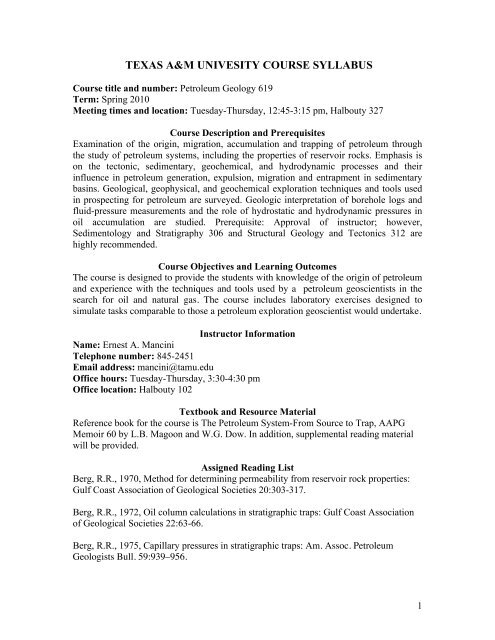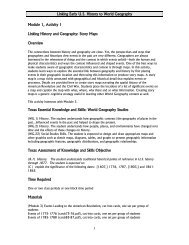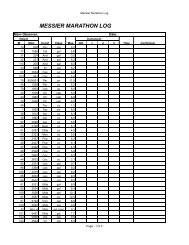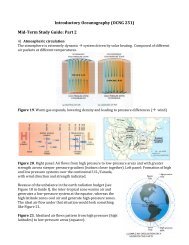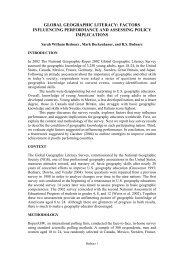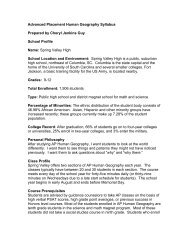Petroleum Geology 61.. - Texas A&M University
Petroleum Geology 61.. - Texas A&M University
Petroleum Geology 61.. - Texas A&M University
You also want an ePaper? Increase the reach of your titles
YUMPU automatically turns print PDFs into web optimized ePapers that Google loves.
TEXAS A&M UNIVESITY COURSE SYLLABUS<br />
Course title and number: <strong>Petroleum</strong> <strong>Geology</strong> 619<br />
Term: Spring 2010<br />
Meeting times and location: Tuesday-Thursday, 12:45-3:15 pm, Halbouty 327<br />
Course Description and Prerequisites<br />
Examination of the origin, migration, accumulation and trapping of petroleum through<br />
the study of petroleum systems, including the properties of reservoir rocks. Emphasis is<br />
on the tectonic, sedimentary, geochemical, and hydrodynamic processes and their<br />
influence in petroleum generation, expulsion, migration and entrapment in sedimentary<br />
basins. Geological, geophysical, and geochemical exploration techniques and tools used<br />
in prospecting for petroleum are surveyed. Geologic interpretation of borehole logs and<br />
fluid-pressure measurements and the role of hydrostatic and hydrodynamic pressures in<br />
oil accumulation are studied. Prerequisite: Approval of instructor; however,<br />
Sedimentology and Stratigraphy 306 and Structural <strong>Geology</strong> and Tectonics 312 are<br />
highly recommended.<br />
Course Objectives and Learning Outcomes<br />
The course is designed to provide the students with knowledge of the origin of petroleum<br />
and experience with the techniques and tools used by a petroleum geoscientists in the<br />
search for oil and natural gas. The course includes laboratory exercises designed to<br />
simulate tasks comparable to those a petroleum exploration geoscientist would undertake.<br />
Instructor Information<br />
Name: Ernest A. Mancini<br />
Telephone number: 845-2451<br />
Email address: mancini@tamu.edu<br />
Office hours: Tuesday-Thursday, 3:30-4:30 pm<br />
Office location: Halbouty 102<br />
Textbook and Resource Material<br />
Reference book for the course is The <strong>Petroleum</strong> System-From Source to Trap, AAPG<br />
Memoir 60 by L.B. Magoon and W.G. Dow. In addition, supplemental reading material<br />
will be provided.<br />
Assigned Reading List<br />
Berg, R.R., 1970, Method for determining permeability from reservoir rock properties:<br />
Gulf Coast Association of Geological Societies 20:303-317.<br />
Berg, R.R., 1972, Oil column calculations in stratigraphic traps: Gulf Coast Association<br />
of Geological Societies 22:63-66.<br />
Berg, R.R., 1975, Capillary pressures in stratigraphic traps: Am. Assoc. <strong>Petroleum</strong><br />
Geologists Bull. 59:939–956.<br />
1
Biddle, K.T., and Wielchowsky, 1994, Hydrocarbon traps, in L.B. Magoon and W.G.<br />
Dow, eds., The petroleum system-from source to trap: AAPG Memoir 60, p. 219-236.<br />
Claypool, G.E., and Mancini, E.A., 1989, Geochemical relations of petroleum in<br />
Mesozoic reservoirs and carbonate source rocks of Jurassic Smackover Formation,<br />
southwestern Alabama: Am. Assoc. <strong>Petroleum</strong> Geologists Bull. 73:904–924.<br />
Embry, A.F., 2002, Transgressive-regressive (T-R) sequence stratigraphy, in J.M.<br />
Armentrout and N.C. Rosen, eds., Sequence stratigraphic models for exploration and<br />
production: evolving methodology, Emerging models and application history:<br />
Proceedings of the 22 nd Annual Bob F. Perkins Research Conference: Gulf Coast Section<br />
SEPM Foundation, p. 151-172.<br />
Galloway, W.E., 1989, Genetic stratigraphic sequences in basin analysis I: Architecture<br />
and genesis of flooding-surface bounded depositional units: Am. Assoc. <strong>Petroleum</strong><br />
Geologists Bull. 73:125-142.<br />
Jordan, C.F., Jr., and Wison, J.L., 1994, Carbonate reservoir rocks, in L.B. Magoon and<br />
W.G. Dow, eds., The petroleum system-from source to trap: AAPG Memoir 60, p. 141-<br />
158.<br />
Katz, B.J., Mancini, E.A., and Kitchka, A.A., 2008, A review and technical summary of<br />
the AAPG Hedberg Research Conference on origin of petroleum-biogenic and/or<br />
abiogenic and its significance in petroleum exploration: Am. Assoc. <strong>Petroleum</strong><br />
Geologists Bull. 92:549-556.<br />
Kingston, D.R., Dishroon, C.P., and Williams, P.A., 1983a, Global basin classification<br />
system: Am. Assoc. <strong>Petroleum</strong> Geologists Bull. 67:2175-2193.<br />
Kingston, D.R., Dishroon, C.P., and Williams, P.A., 1983b, Hydrocarbon plays and<br />
global basin classification system: Am. Assoc. <strong>Petroleum</strong> Geologists Bull. 67:2194-2198.<br />
Klemme, H.D., 1994, <strong>Petroleum</strong> systems of the world involving Upper Jurassic source<br />
rocks, in L.B. Magoon and W.G. Dow, eds., The petroleum system-from source to trap:<br />
AAPG Memoir 60, p. 51-72.<br />
Magoon, L.B., and Dow, W.G., 1994, The petroleum system-from source to trap, in L.B.<br />
Magoon and W.G. Dow, eds., The petroleum system-from source to trap: AAPG Memoir<br />
60, p. 3-24.<br />
Mancini, E.A., Aurell, M., Llinas, J.C., Parcell, W.C., Badenas, B., and Benson, D.J.,<br />
2004, Upper Jurassic thrombolite reservoir play, northeastern Gulf of Mexico: Am.<br />
Assoc. <strong>Petroleum</strong> Geologists Bull. 88:1573-1602.<br />
Mancini, E.A., Badali, M., Puckett, T.M., Parcell, W.C., and Llinas, J.C., 2001, Mesozoic<br />
carbonate petroleum systems in the northeastern Gulf of Mexico, in R.H. Fillon, N.C.<br />
2
Rosen, P. Weimer, A. Lowrie, H. Pettingill, R.L. Phair, H.H. Roberts, and B. van Hoorn,<br />
ed., <strong>Petroleum</strong> systems of deep-water basins: Global and Gulf of Mexico experience,<br />
Proceedings of the 21 st Annual Bob F. Perkins Research Conference: Gulf Coast Section<br />
SEPM Foundation, p. 423-451.<br />
Mancini, E.A., Blasingame, T.A., Archer, R., Panetta, B.J., Haynes, C.D., and Benson,<br />
D.J., 2004, Improving hydrocarbon recovery from mature oil fields producing from<br />
carbonate facies through integrated geoscientific and engineering reservoir<br />
characterization and modeling studies, Upper Jurassic Smackover Formation, Womack<br />
Hill Field (Eastern Gulf Coast, USA): Am. Assoc. <strong>Petroleum</strong> Geologists Bull. 88:1629-<br />
1651.<br />
Mancini, E.A., Katz, B.J., and Kitchka, A.A., (eds.), 2005, Origin of <strong>Petroleum</strong> Program<br />
and Abstracts Volume: AAPG Research Conference, Calgary, 51 p.<br />
Mancini, E.A., Li., P., Ramirez, V.O., Goddard, D.A., and Talukdar, S.C., 2008,<br />
Mesozoic (Upper Jurassic-Lower Cretaceous) deep gas reservoir play, central and eastern<br />
Gulf Coastal Plain: USA, Am. Assoc. <strong>Petroleum</strong> Geologists Bull. 92:283-308.<br />
Mancini, E.A., Mink, R.M., Bearden, B.L., Mann, S.D., and Bolin, D.E., 1990,<br />
Environments of deposition and petroleum geology of the Norphlet Formation (Jurassic),<br />
Hatter's Pond Field, Mobile County, southwestern Alabama, in Sandstone <strong>Petroleum</strong><br />
Reservoirs: Springer-Verlag, p. 153-180.<br />
Mancini, E.A., Mink, Robert M., Bearden, B.L., and Wilkerson, R.P., 1985, Norphlet<br />
Formation (Upper Jurassic) of southwestern and offshore Alabama: Environments of<br />
deposition and petroleum geology: Am. Assoc. <strong>Petroleum</strong> Geologists Bull. 69:881-898.<br />
Mancini, E.A., Mink, R.M., Payton, J. W., and Bearden, B.L., 1987, Environments of<br />
deposition and petroleum geology of the Tuscaloosa Group (Upper Cretaceous), South<br />
Carlton and Pollard Fields, southwestern Alabama: Am. Assoc. <strong>Petroleum</strong> Geologists<br />
Bull. 71:1128-1142.<br />
Mancini, E.A., Obid, J., Badali, M., Liu, K., and Parcell, W.C., 2008, Sequencestratigraphic<br />
analysis of Jurassic and Cretaceous strata and petroleum exploration in the<br />
central and eastern Gulf Coastal Plain, United States: Am. Assoc. <strong>Petroleum</strong> Geologists<br />
Bull. 92:1655-1686.<br />
Mancini, E.A., Parcell, W.C., Ahr, W.M., Ramirez, V.O., Llinas, J.C., and Cameron, M.,<br />
2008, Upper Jurassic updip stratigraphic trap and associated Smackover microbial and<br />
nearshore carbonate facies, eastern Gulf Coastal Plain: USA, Am. Assoc. <strong>Petroleum</strong><br />
Geologists Bull. 92:409-434.<br />
Mancini, E.A., Parcell, W.C., Puckett, T.M., and Benson, D.J., 2003, Upper Jurassic<br />
(Oxfordian Smackover carbonate petroleum system characterization and modeling,<br />
3
Mississippi Interior Salt Basin area, northeastern Gulf of Mexico, USA: Carbonates and<br />
Evaporites, 18:125-150.<br />
Morse, D.G., 1994, Siliciclastic reservoir rocks, in L.B. Magoon and W.G. Dow, eds.,<br />
The petroleum system-from source to trap: AAPG Memoir 60, p. 121-140.<br />
Posamentier, H.W., Jervey, M.T., and Vail, P.R., 1988, Eustatic controls on clastic<br />
deposition I-Conceptual framework, in C.K. Wilgus, B.S. Hastings, C.A. Ross, H.W.<br />
Posamentier, J. C. van Wagoner, and C.G.St.C. Kendall, eds., Sea level changes: An<br />
integrated approach: SEPM Special Publication 42, p. 109-124.<br />
Post, P.J., Harrison, P.F., Whittle, G.L., and Hunt, J.D., 2001, Mesozoic ultra-deep water<br />
potential of the U.S. Gulf of Mexico-Conceptual play development and analysis, in R.H.<br />
Fillon, N.C. Rosen, P. Weimer, A. Lowrie, H. Pettingill, R.L. Phair, H.H. Roberts, and B.<br />
van Hoorn, ed., <strong>Petroleum</strong> systems of deep-water basins: Global and Gulf of Mexico<br />
experience, Proceedings of the 21 st Annual Bob F. Perkins Research Conference: Gulf<br />
Coast Section SEPM Foundation, p. 35-69.<br />
Rowan, E.L., and Warwick, P.D., 2007, Thermal maturation history of the Wilcox Group<br />
(Paleocene-Eocene), <strong>Texas</strong>: Results of regional-scale multi-1D modeling, in L. Kennan,<br />
J. Pindell, and N.C. Rosen, eds., The Paleogene of the Gulf of Mexico and Caribbean<br />
basins, Proceedings of the 27 th Annual Bob F. Perkins Research Conference: Gulf Coast<br />
Section SEPM Foundation, p. 714-743.<br />
Salvador, A., 1991, Origin and development of the Gulf of Mexico basin, in A. Salvador,<br />
ed., The Gulf of Mexico basin: Geological Society of America, Decade of North<br />
American <strong>Geology</strong>, v. J, p. 389-444.<br />
Sawyer, D.S., Buffler, R.T., and Pilger, R.H., Jr., 1991, The crust under the Gulf of<br />
Mexico, in A. Salvador, ed., The Gulf of Mexico basin: Geological Society of America,<br />
Decade of North American <strong>Geology</strong>, v. J, p. 53-72.<br />
Sassen, R., 1990, Lower Tertiary and Upper Cretaceous Source Rocks in Louisiana and<br />
Mississippi: Implications to Gulf of Mexico crude oil: Am. Assoc. <strong>Petroleum</strong> Geologists<br />
Bull. 74:857-878.<br />
Waples, D.W., 1994, Maturity modeling: Thermal indicators, hydrocarbon generation,<br />
and oil cracking, in L.B. Magoon and W.G. Dow, eds., The petroleum system-from<br />
source to trap: AAPG Memoir 60, p. 285-306.<br />
Warwick, P.D., Coleman, J.L., Hackley, P.C., Hayba, D.O., Karlsen, A.W., Rowan, E.L.,<br />
and Swanson, S.M., 2007, USGS assessment of undiscovered oil and gas resources in<br />
Paleogene strata of the U.S. Gulf of Mexico coastal plain and state waters, in L. Kennan,<br />
J. Pindell, and N.C. Rosen, eds., The Paleogene of the Gulf of Mexico and Caribbean<br />
basins, Proceedings of the 27 th Annual Bob F. Perkins Research Conference: Gulf Coast<br />
Section SEPM Foundation, p. 2-43.<br />
4
Grading Policies<br />
Grade Determination<br />
Class exercises 30%<br />
Mid-term examination 35%<br />
Final examination 35%<br />
Grade Scale<br />
A grading scale of A=>90, B=80-89, C=70-79, D=60-69, F=
http://certmapper.cr.usgs.gov/rooms/we/index.jsp?thePage=include_results.jsp&subSetD<br />
ocId={EA23CD2C-DC9E-4BE2-8653-598F6CAB8B98}&folderToggle=true<br />
February 2: Lecture-discussion of petroleum systems.<br />
Reading materials-Magoon and Dow (1994), Klemme (1994), Sassen (1990), Claypool<br />
and Mancini (1989), and Rowan et al. (2007).<br />
February 4: Lecture-discussion on chronostratigraphy and sequence stratigraphy and<br />
their application to identifying components of the petroleum system.<br />
Reading materials-Posamentier et al. (1988), Galloway (1989), Embry (2002), and<br />
Mancini et al. (2008).<br />
February 9-11: Exercise-Make a preliminary evaluation of the hydrocarbon potential of<br />
the sedimentary basin you have selected. Prepare a 1-page summary of your findings for<br />
class on February 16.<br />
Resource materials-USGS web site as listed above.<br />
February 16-18: Lectures-discussion on the application of the concepts of sedimentary<br />
basin types, petroleum systems and sequence stratigraphy to evaluating the petroleum<br />
potential of the onshore Mesozoic salt basins in the northern Gulf of Mexico.<br />
Reading materials-Salvador (1991), Sawyer et al. (1991), Mancini et al. (2001), Post et<br />
al. (2001), and Warwick et al. (2007).<br />
February 23-25: Exercise-Make a preliminary determination of the petroleum systems<br />
associated with the sedimentary basin you have selected using sequence stratigraphic<br />
analysis. Prepare a 1-page summary of your findings for class on March 2.<br />
Resource materials-USGS web site as listed above, class reading material and literature<br />
search.<br />
March 2-4: Lectures-discussion on field case studies illustrating an integrated approach<br />
of using geological, geophysical, petrophysical, and engineering concepts and utilizing<br />
well logs and cores, geochemical data, seismic sections, and subsurface mapping in<br />
reservoir characterization and evaluation.<br />
Reading materials- Berg (1970) and Mancini et al. (1985, 1987, 1990, 2004, 2008).<br />
March 2: Mid-term examination.<br />
March 9-11: Exercise-Field study involving well logs, preparing cross sections, and<br />
constructing subsurface maps.<br />
March 15-19: Spring Break<br />
March 23: Lecture-discussion on sandstone reservoir facies and characteristics.<br />
Reading material-Morse (1994).<br />
March 25: Lecture-discussion on carbonate reservoir facies and characteristics.<br />
6
Reading material-Jordan and Wilson (1994).<br />
March 30-April 1: Describe 2 cores (sandstone and carbonate).<br />
April 6-8: Lectures-discussion on petroleum source and seal rocks and on petroleum<br />
generation, expulsion, migration, and accumulation.<br />
Reading materials-Waples (1994) and Mancini et al. (2003, 2008).<br />
April 13-15: Exercise-Modeling of oil and gas generation, expulsion, and migration.<br />
April 20: Lecture-discussion on petroleum traps (structural, stratigraphic, hydrostatic and<br />
hydrodynamic).<br />
Reading materials-Berg (1972, 1975) and Biddle and Wielchowsky (1994).<br />
April 22: Lecture-discussion on field case study illustrating the use of 3-D seismic data.<br />
Reading material-Mancini et al. (2004).<br />
April 27-29: Exercise-Field study involving 3-D seismic data.<br />
May 7: Final examination.<br />
Americans with Disabilities Act (ADA)<br />
The Americans with Disabilities Act (ADA) is a federal anti-discrimination statute that<br />
provides comprehensive civil rights protection for persons with disabilities. Among other<br />
things, this legislation requires that all students with disabilities be guaranteed a learning<br />
environment that provides for reasonable accommodation of their disabilities. If you<br />
believe you have a disability requiring an accommodation, please contact Disability<br />
Services, in Cain Hall, Room B118, or call 845-1637. For additional information visit<br />
http://disability.tamu.edu<br />
Academic Integrity<br />
The Honor Code, based on the long-standing affirmation that An Aggie does not lie,<br />
cheat, or steal or tolerate those who do, is fundamental to the value of the A&M<br />
experience. Know the Code. Aggie Code of Honor: "An Aggie does not lie, cheat, or<br />
steal or tolerate those who do." http://www.tamu.edu/aggiehonor/<br />
Plagiarism<br />
If you have any questions about plagiarism and/or copying, please consult the latest issue<br />
of the <strong>Texas</strong> A&M <strong>University</strong> Student Rules, under the section "Scholastic Dishonesty."<br />
Copyright<br />
If you have questions regarding copyright issues, please discuss these with me.<br />
7


